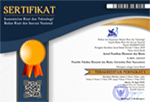Upaya Brand Salience untuk Mendorong Terjadinya Brand Resonance
DOI:
https://doi.org/10.33633/jpeb.v5i1.3280Abstract
This study aims to examine an integrated model of brand salience, perceived quality, buying decision, brand feeling, and brand resonance to the readers of Suara Merdeka Newspaper in Semarang. The sample of this study was 135 readers of Suara Merdeka Newspaper in Semarang. Exogenous and endogenous measurements have been approved using confirmatory analysis. Furthermore, it is analyzed with the Structural Equation Model to examine the causality relationship between the variables that influence and are measured by brand salience, purchasing decisions, perceived quality, brand feelings and brand resonance. Conclusions from the results of this study indicate that to increase brand resonance can be obtained through brand feelings obtained from the confidence of the purchase results due to brand excellence (Brand Salience).Keywords: : Brand Resonance; Brand Salience; Brand Feeling; buying decision; Perceived Quality 3Penelitian ini bertujuan untuk menguji model terintegrasi brand salience, perpsepsi kualitas, keputusan pembelian, brand feeling, brand resonance kepada para pembaca Surat Kabar Suara Merdeka di Semarang. Sampel penelitian ini adalah 135 pembaca Surat Kabar Suara Merdeka di Semarang. Pengukuran eksogen dan endogen telah diuji dengan menggunakan analisis konfirmatori. Selanjutnya dianalisis dengan Structural Equation Model untuk pengujian hubungan kausalitas antar variabel-variabel yang mempengaruhi dan dipengaruhi oleh brand salience, keputusan pembelian, perceived quality, brand feeling dan brand resonance. Simpulan dari hasil penelitian ini menunjukkan bahwa untuk meningkatkan Brand Resonance dapat dicapai melaui Brand Feeling yang diperoleh dari keyakinan keputusan pembelian karena kemenonjolan merek (Brand Salience).Kata Kunci: Brand Resonance; Brand Salience; Brand Feeling; Keputusan Pembelian; Perceived QualityReferences
Broyles, S. Allen, David W. Schumann (2004). The Comparative Influence of Brand Equity’s Experiential and Functional Antecedents and Its Consequences on U.S and Mainland Chinese Consumers, AIB-SE (USA) Annual Marketing, Knoxville, TN.
Broyles, S. Allen, David W. Schumann, and Thaweephan Leingpibul (2009). Examining Brand Equity Antecedent/ Consequence Relationships, Journal of Marketing Theory and Practice, Vol 17, No 2 (Spring 2009) pp 145-161
Fandos & Flavian (2006). Intrinsic and extrinsic quality attributes, loyalty and buying intention: an analysis for a PDO product. British food journal, 108
Jahangir, Nadim, Noorjahan Parves, Dhrubanil Bhattacharjee, Khondaker Khaled (2009). The Relationship Between Brand Affect, Brand Quality, and Customers’ Brand Extension Attitude: Exploring The Mediating Role Of Customer Loyalty, The Cambodian Manajemen Journal, Vol. 1, No. 1, 20-34.
Knight, Dee K dan Kim, Eun Young (2007). Japanese consumers’ need for uniqueness, Effect on
brand perceptions and purchase intention, Journal of Fashion Marketing and Management, Vol 11 No2 pp 272
Kotler, Philip. 2009. Manajemen Pemasaran. Jakarta: Erlangga
___________. 2009. Manajemen Pemasaran (Jilid 2). Jakarta: PT. Ikrar Mandiri.
Raggio, Randle D dan Robert P Leone, 2007, The theoretical separation of brand equity and brand value: Manajerial implication for strategic planning, Palgrave Macmillan Ltd, Brand Management, Vol. 14, No. 5, 380-395
Romaniuk, Jenni, Byron Sharp (2002). The Concept of Brand Salience and Impliation for
Measurement, paper presented of The European Marketing Academy 31st Annual Conference, University of Minho.
Sutisna (2001). Perilaku Konsumen & Komunikasi Pemasaran, Remaja Rosdakarya, Bandung.
Tsiotsou, Rodoula (2005). Perceived Quality Levels and their Relation to Involvement, satisfaction, and Purchase Intentions, Marketing Bulletin, 16 Thomson,
Matthew, Deborah J. MacInnis and C Whan Park (2005). The Ties That Bind: Measuring The Strength Of Consumers’ Emotional Attachments To Brand, Journal of Consumer Pshychology, 15(1), 77-91
Vieceli, Julian, Frank Alpert (2002). Redefining Brand Salience Using Memory Theory and Implications for Measurement, Conference Proceedings, ANZMAC Deakin University
Vieceli, Julian; Sharp, Byron (2001), “Inhibiting Effect of brand salience on recall†Australian Marketing Academy conference proceedings, Massey University, Albany, New Zealand.
Yoo, Boonghee, Naveen Donthu, Sungho lee, (2000), An Examination of Selected Marketing Mix Element and Brand Equity, Academy of Marketing Science; Journal: Spring, 28,2; ABI/INFORM Global P.195
Downloads
Published
How to Cite
Issue
Section
License
The copyright of the received article shall be assigned to the journal as the publisher of the journal. The intended copyright includes the right to publish the article in various forms (including reprints). The journal maintains the publishing rights to the published articles.
This work is licensed under a Creative Commons Attribution 4.0 International License.


.png)









